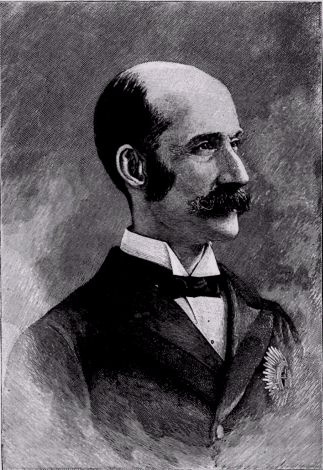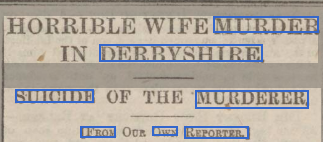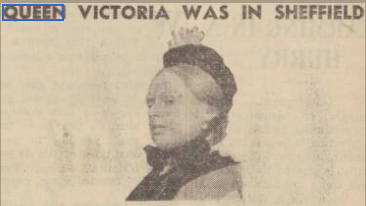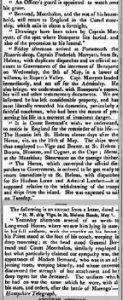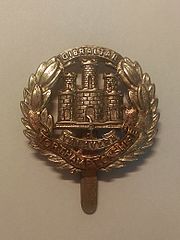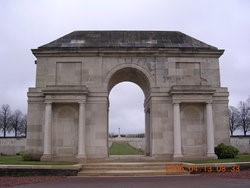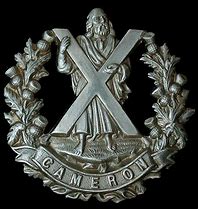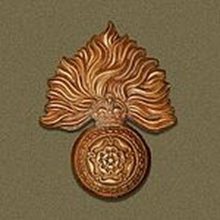The following are various particulars connected with the last moments of this extraordinary man – Extract of a Private Letter, dated St. Helena, May 15.
Bonaparte was buried on the 9th in the Sane Valley, a spot selected by himself, with the full military honours paid to a General of the first rank. His coffin was carried by grenadiers. Count Montholon and General Bertrand were the poll-bearers, Madame Bertrand with her family following. Next came Lady Lowe and her daughters in deep mourning; then the junior officers the navy; the staff of the army; last, Sir Hudson Lowe and the Admiral brought up the rear. The 66th and 20th regiments, the artillery, volunteers, and marines, in all full 3,000 men, were stationed on the surrounding hills, about half way up; and when the body was lowered into the grave, three rounds of eleven guns were fired by the artillery. His grave was about fourteen feet deep, very wide at the top, but the lower part chambered to receive the coffin. One large stone covered the whole of the chamber; the remaining space was filled up with solid masonry clamped with iron. Thus every precaution is taken to prevent the removal of the body, and I believe it has been full as much by the desire of the French Commissioners, as from the wish of the Government of the island. The spot had previously been consecrated by his priest. The body of Bonaparte is enclosed in three coffins, of mahogany, lead and oak. His heart, which Bertrand and Montholon earnestly desired to take with them to Europe, was restored to the coffin, but it remains in a silver cup, filled with spirits. His stomach his surgeon was anxious to preserve, but that is also preserved, and is in another silver cup.
As everything relating to so great a man must be of extreme interest, I should tell you, that after having attended his funeral I paid a visit to his residence. I was shown his wardrobe by Marchand, his valet, and a more shabby set-out I never beheld. Old coats, hats, and pantaloons, that a midshipman on shore would hardly condescend to wear. But Marchand said, it was quite an undertaking to make him put on anything new, and then after wearing it an hour, be would throw it off, and put on the old again.
The last words Bonaparte uttered were ‘tele’ “armee.’ —What their connexion was in his mind cannot be ascertained; but they were distinctly heard about five o’clock on the morning of the day he died.
An Officer’s guard is appointed to watch over his grave. Bertrand, Montholon, and the rest of his household, will return to England in the Camel store-ship, which tails in about a fortnight, Drawings have been taken by Captain Marryatt, of the spot where Bonaparte lies buried, and also of the procession to his funeral.
Friday afternoon arrived at Portsmouth the Rosario sloop. Captain Frederick Marryatt, from St. Helena, with duplicate dispatches and an official account to Government of the interment of Bonaparte on Wednesday, the 9th of May, in a bower of willows, in Rupert’s Valley. Capt. Marryatt landed immediately and set off for the Admiralty. He also brings, we understand, with Bonaparte’s papers, his will and other testamentary documents. We are informed he has left considerable property, and has most liberally rewarded his domestics, particularly faithful coachman, who bad been the means of preserving bis life in a moment of imminent danger. It is Count Bertrand’s wish 9 we understand, to reside in England for the remainder of his life.
The Rosario left St. Helena eleven days after the Heron, viz. on the 18th of May. The ships were thus employed :—Vigo and Beaver, at St. Helena ; Brazen, Blossom, and Cygnet, at the Cape; Menai, at the Mauritius; Shearwater on the passage thither. The Heron, which conveyed the official dispatches to Government, is ordered to be got ready to return immediately to St. Helena, with dispatches for Sir Hudson Lowe and Admiral Lambert—it is supposed relative to the withdrawing of the troops and ships from the island. She was expected to sail on Tuesday.”
The following is an extract from a letter, dated H. M. ship Vigo, in St. Helens Roads, May 7. Yesterday afternoon several of us went, to Longwood House, where we saw him lying in state, in his full uniform, with the crucifix hit breast; kit Priest stood at the foot of his couch, weeping, in deep mourning; at the head stood General Bertrand and Count Montholon, similarly employed ; but what particularly claimed our sympathy was, the appearance of Madam Bertrand, who was in an adjoining room, weeping bitterly, and whose converse discovered the strength of her attachment and her deep regret for the deceased. The uniform which he bad on was the same which he wore, with al hit stars, and orders, after the battle of Marengo’— Hampshire Telegraph.
Saunders’s News-Letter – Thursday 12 July 1821
British Newspaper Archives
Similar Posts
